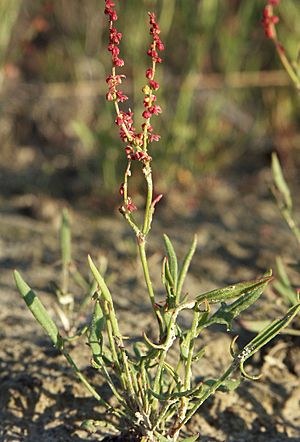Red sorrel facts for kids
Quick facts for kids Red sorrel |
|
|---|---|
 |
|
| Scientific classification | |
| Genus: |
Rumex
|
| Species: |
acetosella
|
| Synonyms | |
|
Acetosella vulgaris (W.D.J. Koch) Fourr. |
|
Rumex acetosella, often called red sorrel or sheep's sorrel, is a type of flowering plant. It belongs to the buckwheat family, called Polygonaceae. This plant is originally from Europe and Asia. It is a common perennial plant, meaning it grows back every year. It often grows as a weed in many places. Sheep's sorrel has green leaves shaped like arrowheads. Its stems are reddish and have deep ridges. It spreads easily using underground stems called rhizomes. The plant's flowers grow on a tall, straight stem. Female flowers are a deep red color.
Contents
What Does Sheep's Sorrel Look Like?
Sheep's sorrel is a perennial herb. This means it lives for more than two years and often comes back each spring. It spreads using rhizomes, which are like underground stems. These rhizomes help the plant grow new shoots and spread out.
The plant has a thin, reddish stem that stands upright. It can grow up to 50 centimetres (20 inches) tall. The stem branches out near the top. Its leaves are small and shaped like arrows. They are about 2.4–5 cm (1–2 in) long and .5–2 cm (1⁄4–3⁄4 in) wide. The leaves have pointed parts at their base.
Sheep's sorrel blooms from March to November. It has small flowers that grow at the top of the stem. Some plants have yellowish-green male flowers. Other plants have reddish female flowers. These flowers later turn into small red fruits, which are the plant's seeds.
It is important not to confuse this plant with a similar one called R. acerosella. Both plants contain a chemical called oxalic acid. Eating too much of either plant is not good for you.
Where Does Sheep's Sorrel Grow?
Sheep's sorrel first came from Eurasia and the British Isles. But now, it has spread to most of the Northern Hemisphere. You can often find it growing in places with acidic, sandy soils. It likes areas like heaths and grasslands.
This plant is often one of the first to grow in places that have been disturbed. For example, it can grow well in old mining sites. This is especially true if the soil there is acidic.
Sheep's sorrel is a dioecious plant. This means that male and female flowers grow on separate plants. One plant will have only male flowers, and another plant will have only female flowers.
How Does Sheep's Sorrel Interact with Nature?
Livestock like cows and sheep might eat sheep's sorrel. However, it is not very healthy for them. It can even be harmful in large amounts. This is because it contains chemicals called oxalates. In the past, an Italian farmer named Nicola Onorati found that this plant can harm the teeth of animals that eat a lot of it. This damage is due to the oxalic acid inside the plant.
Small birds that feed on the ground enjoy eating the seeds of sheep's sorrel. Larger animals, such as rabbits and deer, also eat its green leaves.
The American copper butterfly, also known as the small copper butterfly, needs sheep's sorrel for food. Its caterpillars eat the leaves of this plant to grow.
Farmers often see sheep's sorrel as a difficult weed to control. This is because its underground stems (rhizomes) help it spread very quickly. Blueberry farmers know this weed well. This is because sheep's sorrel grows best in the same conditions that blueberries need to thrive.
Is Sheep's Sorrel Safe to Eat?
Sheep's sorrel contains oxalic acid and related chemicals called oxalates. These are natural chemicals found in many plants.
Uses of Sheep's Sorrel
The leaves of sheep's sorrel can be eaten raw or cooked. If you cook them, you might want to change the water. This helps to make their strong taste less intense. The oxalic acid in the leaves gives them a slightly sour taste.
People use sheep's sorrel in many ways when preparing food. It can be used as a garnish to decorate dishes. It also works as a tart flavoring agent, adding a sour kick to meals. Some people add it to salads as a green leafy vegetable. It can even be used to curdle milk, which helps in making cheese. The leaves taste a bit like lemon, tangy, or like rhubarb. In some places, it is also known as "sheep shower."
See also
 In Spanish: Acedorilla para niños
In Spanish: Acedorilla para niños

